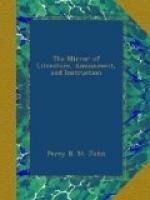THE FORTUNE PLAYHOUSE.
[Illustration: The Fortune Playhouse.]
The Engraving represents one of the playhouses of Shakspeare’s time, as the premises appeared a few years since. This theatre was in Golden Lane, Barbican, and was built by that celebrated and benevolent actor Edward Alleyn, the pious founder of Dulwich College, in 1599. It was burnt in 1624, but rebuilt in 1629. A story is told of a large treasure being found in digging for the foundation, and it is probable that the whole sum fell to Alleyn. Upon equal probability, is the derivation of the name “The Fortune.” The theatre was a spacious brick building, and exhibited the royal arms in plaster on its front. These are retained in the Engraving; where the disposal of the lower part on the building into shops, &c. is a sorry picture of the “base purposes” to which a temple of the Drama has been converted.
According to the testimony of Ben Jonson and others, Alleyn was the first actor of his time, and of course played leading characters in the plays of Shakspeare and Jonson. He was probably the Kemble of his day, for his biographers tell us such was his celebrity, that he drew crowds of spectators after him wherever he performed; so that possessing some private patrimony, with a careful and provident disposition, he soon became master of an establishment of his own—and this was the Fortune. Although Alleyn left behind him a large sum, it is hardly probable that he made it here; for in his diary, which, we believe is extant, he records that he once had so slender an audience, that the whole receipts of the house amounted to no more than three pounds and a few odd shillings—a sum which would not pay the expenses; for it appears by the Ms. of Lord Stanhope, treasurer to James I. that the customary sum paid for the performance of a play at court, was 20 nobles, or 6l. 12s. 4d.[1] Alleyn was likewise proprietor of the Blackfriars’ Theatre, near what is still called Playhouse Yard. However he might have gathered laurels on the stage, he must have gained his fortune by other means. He was keeper of the King’s Bear Garden and Menagerie, which were frequented by thousands, and produced Alleyn, the then great sum of 500_l_. per annum. He was also thrice married, and received portions with his two first wives; and we need not insist upon the turn which matrimony gives to a man’s fortune.
[1] The nightly expenses of
Drury Lane and Covent Garden Theatres
in
these days, are upwards of 200_l_.
Among the theatrico-antiquarian gossip of The Fortune is, that it was once the nursery for Henry VIII.’s children—but “no scandal about the”—we hope.
* * * * *
FINE ARTS
* * * * *
EXHIBITION OF THE ROYAL ACADEMY.




